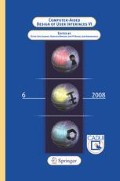Abstract
A model-driven engineering method is presented that provides designers with methodological guidance on how to systematically derive user interfaces of workflow information systems from a series of models. For this purpose, a workflow is recursively decomposed into processes that are in turn decomposed into tasks. Each task gives rise to a task model whose structure, ordering, and connection with the domain model allows a semi-automated generation of corresponding user interfaces by model-to-model transformation. Reshuffling tasks within a same process or reordering processes within a same workflow is straightforwardly propagated as a natural consequence of the mapping model used in the model-driven engineering. The various models involved in the method can be edited in a graphical editor based on Petri nets and simulated interactively. This editor also contains a set of workflow user interface patterns that are ready to use. The output file generated by the editor can then be exploited by a workflow execution engine to produce a running workflow system.
Access this chapter
Tax calculation will be finalised at checkout
Purchases are for personal use only
References
Stavness, N., Schneider, K.A.: Supporting Flexible Business Processes with a Progression Model. In: Proc. of the 1st Int. Workshop on Making model-based user interface design practical: usable and open methods and tools MBUI’2004 (Funchal, January 13, 2004) CEUR Workshop Proceedings, Vol. 103. Accessible at http://sunsite.informatik.rwth-aachen.de/Publications/CEUR-WS//Vol-103/stavness-et-al.pdf.
van der Aalst, W.M.P., van Hee, K.: Workflow Management: Models, Methods, and Systems. The MIT Press, Cambridge (2002).
van der Aalst, W.M.P., ter Hofstede, A.H.M.: YAWL: Yet Another Workflow Language. Information Systems 30, 4 (2005) 245–275.
van Hee, K., Oanea, O., Post, R., Somers, van der Werf, J.M.: Yasper: a tool for workflow modeling and analysis. In: Proc. of 6th Int. Conf. on Application of Concurrency to System Design (2006) 279–282.
Dumas, M., ter Hofstede, A.: UML Activity Diagrams as a Workflow Specification Language. In: Proc. of 4th Int. Conf. on the Unified Modeling Language, Concepts, and Tools UML’2001 (Toronto, October 1–5, 2001). Lecture Notes in Computer Science, Vol. 2185. Springer, Berlin (2001) pp. 76–90.
Lee, H. B., Kim, J. W., Park, S. J.: KWM: Knowledge-based Workflow Model for Agile Organization. Journal of Intelligent Information Systems 13 (1999) 261–278.
van der Aalst, W.M.P., Kumar, A.: XML Based Schema Definition for Support of Inter-organizational Workflow. In: Proc. of 21st Int. Conf. on Application and Theory of Petri Nets ICATPN’2000. LNCS, Vol. 1825. Springer, Berlin (2000) 475–484.
Russell, N., van der Aalst, W.M.P., ter Hofstede, A.H.M., Edmond, D.: Workflow Resource Patterns: Identification, Representation, and Too Support. In: Proc. of 17th Conf. on Advanced Information Systems Engineering CAiSE’2005 (Porto, June 13–17, 2005). Lecture Notes in Computer Science, Vol. 3520. Springer, Berlin (2005) 216–232.
Kristiansen, R., Trætteberg, H.: Model-Based User Interface Design in the Context of Workflow Models. In: Proc. of 6th Int. Workshop on Task Models and Diagrams for User Interface Design TAMODIA’2007 (Toulouse, November 7–9, 2007). Lecture Notes in Computer Science, Vol. 4849. Springer, Berlin (2007) pp. 227–239.
Stolze, M., Riand, Ph., Wallace, M., Heath, T.: Agile Development of Workflow Applications with Interpreted Task Models. In: Proc. of 6th Int. Workshop on Task Models and Diagrams for User Interface Design TAMODIA’2007 (Toulouse, November 7–9, 2007). Lecture Notes in Computer Science, Vol. 4849. Springer, Berlin (2007) 2–14.
Guerrero, J., Vanderdonckt, J., Gonzalez, J.M.: FlowiXML: A Step Towards Designing Workflow Management Systems. Journal of Web Engineering 4, 2 (2008) 163–182.
van der Aalst, W.M.P.: The application of Petri Nets to Workflow Management. Journal of Circuits, Systems, and Computers 8, 1 (1998) 21–66.
Paternò, F. Model-based design and evaluation of interactive applications. Springer (1999).
Puerta, A.R.: A Model-Based Interface Development Environment. IEEE Software 14, 4 (1997) 41–47.
Souchon, N., Vanderdonckt, J.: A review of XML-compliant user interface description languages. In: Proc. of DSV-IS’2003. Springer, Berlin (2003) 377–391.
Calvary, G., Coutaz, J., Thevenin, D., Limbourg, Q., Bouillon, L., Vanderdonckt, J.: A Unifying Reference Framework for Multi-Target User Interfaces. Interacting with Computers 15, 3 (2003) 289–308.
Mandviwalla, M., Olfman, L.: What do groups need? A proposed set of generic groupware requirements. ACM Transactions on Computer-Human Interaction 1, 3 (1994) 245–268.
Palanque, P., Farenc, Ch., Bastide, R.: Embedding Ergonomic Rules as Generic Requirements in a Formal Development Process of Interactive Software. In: Proc. of IFIP TC 13 Int. Conf. on Human-Computer Interaction Interact’99 (Edinburgh, September 1–4, 1999). IOS Press, Amsterdam (1999) 408–416.
Adam, E., Kolski, C., Mandiau, R., Vergison, E.: A software engineering workbench for modeling groupware activities. In: C. Stephanidis (Ed.), Universal Access in HCI: inclusive design in the information society. Lawrence Erlbaum Associates, Mahwah, NJ (2003) pp. 1499–1503.
Author information
Authors and Affiliations
Editor information
Editors and Affiliations
Rights and permissions
Copyright information
© 2009 Springer-Verlag London Limited
About this paper
Cite this paper
García, J.G., Lemaigre, C., Vanderdonckt, J., González Calleros, J.M. (2009). Model-Driven Engineering of Workflow User Interfaces. In: Lopez Jaquero, V., Montero Simarro, F., Molina Masso, J., Vanderdonckt, J. (eds) Computer-Aided Design of User Interfaces VI. Springer, London. https://doi.org/10.1007/978-1-84882-206-1_2
Download citation
DOI: https://doi.org/10.1007/978-1-84882-206-1_2
Published:
Publisher Name: Springer, London
Print ISBN: 978-1-84882-205-4
Online ISBN: 978-1-84882-206-1
eBook Packages: Computer ScienceComputer Science (R0)

